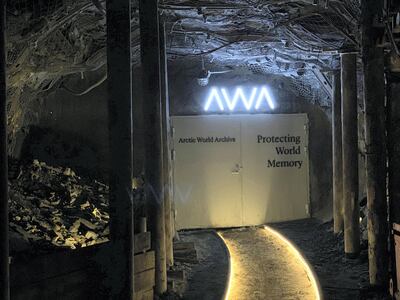Visitor guides describe the Svalbard archipelago, located midway between mainland Norway and the North Pole, as the rugged domain of polar bears. The territory is a three-hour flight from Oslo and sparsely populated save for the apex predators who roam outside the islands' small settlements.
This remote location is home to the Arctic World Archive, described as a repository of global memory by Piql, the Norwegian company at the heart of a project to establish an underground digital treasure trove for eternity.
Today the AWA received new deposits for the first time since the onset of the global coronavirus pandemic, which delayed a previous data drop earlier this year.
Last year, the World Economic Forum estimated that 463 exabytes of data will be created per day by 2025, as our digital world grows ever larger and more complex. Each day a portion of that data is lost, damaged or compromised. Established in 2017, the archive is, according to Piql, a response to the increasing risks around long-term data integrity.
The company's method for storing data is to transfer digital files onto 35mm photosensitive film. Once the film is developed it is put onto reels which can't be hacked and become a self-contained back-up that is not reliant on proprietary software for its retrieval. The data is then cold stored in Svalbard. A similar venture, an archive for global seeds on the archipelago, accepted its millionth deposit in February.
Piql’s disaster-proof vault on the archipelago is located in a decommissioned coal mine belonging to Store Norske, a state-owned mining company, and is accessed via a 300m walk into darkness, past dormant seams of coal.
Rune Bjerkestrand, Piql’s managing director, says the environment is “completely passive” and calls the project a “nice fit” between mining and security expertise and data preservation proficiency. No cooling or electricity is required to keep the vault running. The company says its film will survive for at least 500 years underground.
“It's an immutable medium,” Mr Bjerkestrand said during a video call from Norway, referring to Piql’s radiation-proof film.
“Svalbard is a very unique place,” he adds, in reference to the secure nature of the vault and the fragile beauty of the terrain above it.
The complete works of Poland's Olga Tokarczuk, winner of the Nobel Prize for Literature in 2018, were among the deposits made on Wednesday, as well as high resolution images of the Ajanta Caves in India, a Unesco world heritage site.
Mr Bjerkestrand said at a small ceremony to mark the archive's reopening that the deposits contributed to a “richer picture of our era for the generations to come”.
Several Norwegian museums have also put parts of their catalogue in the vault since 2017. The National Museum of Norway made its third deposit this week, preserving the works of several cultural figures, including Harriet Backer, Britta Marakatt-Labba and Eline Mugaas.
GitHub, the software developer, put source code for the Linux and Android operating systems into the vault earlier this year, as well as copies of a number of programming languages and AI tools.
They took their place alongside a copy of the UN Convention on the Rights of a Child from Unicef and tranches of documents by cultural institutions such as the National Archive of Mexico, the European Space Agency and the Vatican Library.
The AWA, which is a commercial operation, places few restrictions on what can or can’t be kept for eternity, but the organisation is especially interested in preserving heritage and culture. It does not currently store private legacies and personal collections, but says it can see there is a clear interest in that type of service.
“We offer a very attractive location to keep the world's most important information,” Mr Bjerkestrand said.







